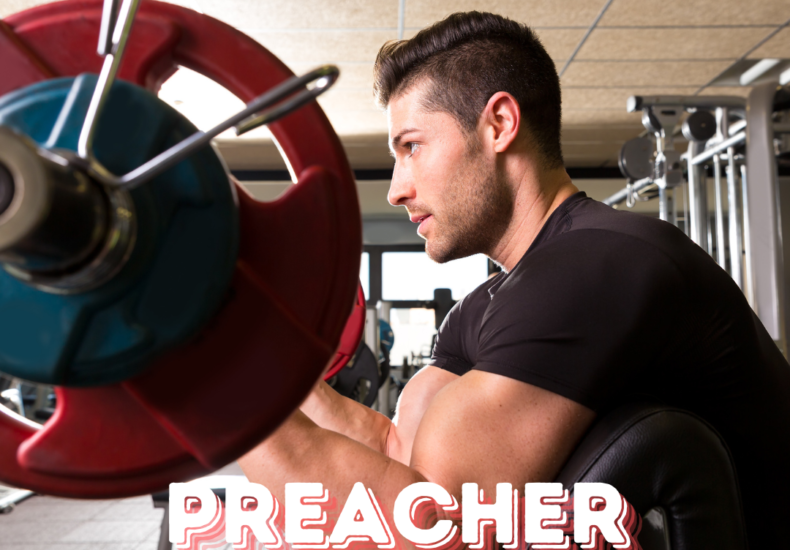
What is the Preacher Curl Good For
The preacher curl is one of the most popular exercises in any arm-training routine, primarily focusing on building the biceps. Whether you’re a seasoned gym-goer or a beginner looking to enhance your arm strength, preacher curls are a must-have exercise for anyone wanting to develop their biceps to the fullest. But what exactly makes this exercise so beneficial, and how can it help you reach your fitness goals?
In this comprehensive guide, we’ll delve into everything you need to know about the preacher curl, including its benefits, the muscles it targets, proper form, and various tips for maximizing its effectiveness. We’ll also answer frequently asked questions (FAQs) to help you get the most out of this classic arm-building exercise.
Anatomy of the Preacher Curl
What is the Preacher Curl?
The preacher curl is a bicep exercise performed using a preacher bench. The preacher bench has a padded surface angled at around 45 degrees, where you rest your upper arms during the exercise. This set-up isolates the biceps, minimizing the use of other muscle groups, thus making the preacher curl one of the best exercises for specifically targeting the biceps.
Equipment Needed:
- A preacher curl bench
- An EZ curl bar, dumbbells, or a straight barbell
Muscles Worked in the Preacher Curl
The preacher curl mainly targets the biceps brachii, the muscle on the front of your upper arm, responsible for flexing the elbow and rotating the forearm. The biceps consist of two heads:
- Long head: Located on the outer side of the biceps and responsible for the biceps’ peak.
- Short head: Located on the inner side, which gives the biceps its width.
The preacher curl emphasizes both heads but places more focus on the short head, due to the forward arm position. Alongside the biceps, other muscles involved include:
- Brachialis: Located under the biceps, it assists in elbow flexion and contributes to arm thickness.
- Forearm muscles: The brachioradialis in particular, helps with grip strength and forearm stability during the exercise.
Benefits of the Preacher Curl
The preacher curl is a powerful addition to your arm routine because it offers several key benefits. Here’s why this exercise is so good for you:
1. Isolation of the Biceps
One of the biggest advantages of the preacher curl is its ability to isolate the biceps. By resting your upper arms on the preacher bench, it eliminates momentum and reduces the use of other muscle groups like the shoulders or lower back, which can often assist during traditional bicep curls. This isolation creates a more focused contraction on the biceps, leading to better muscle activation and growth.
2. Increased Muscle Engagement at the Bottom of the Curl
In standard bicep curls, the bottom part of the movement (when your arms are fully extended) often gets neglected, as other muscles compensate for lifting the weight. The preacher curl forces your biceps to engage throughout the entire range of motion, especially at the bottom of the movement where tension is the highest. This allows for maximum muscle fiber recruitment, leading to better hypertrophy (muscle growth) over time.
3. Enhanced Bicep Development
The preacher curl emphasizes the short head of the biceps, which helps give your arms that “full” look. Regularly incorporating preacher curls into your workout routine can improve both the size and the shape of your biceps, creating a more aesthetic arm. Over time, this can contribute to the coveted biceps peak that many lifters strive for.
4. Reduces Risk of Cheating
In standing curls, there’s often a temptation to “cheat” by swinging the weight or using your body to help lift the bar. The preacher bench effectively minimizes this by preventing body movement and requiring a controlled, strict curl. This helps ensure you’re lifting with proper form, reducing the risk of injury while maximizing the effectiveness of each rep.
5. Improved Mind-Muscle Connection
Because preacher curls isolate the biceps so effectively, they improve your mind-muscle connection. This is the ability to consciously contract a muscle during an exercise, which is important for maximizing muscle growth. Over time, as your mind-muscle connection improves, you’ll be able to target the biceps more effectively in other exercises as well.
6. Good for All Fitness Levels
Whether you’re a beginner or an experienced lifter, preacher curls are suitable for all fitness levels. The exercise can be done using various types of equipment, such as EZ curl bars, dumbbells, or even machines, making it adaptable to your individual needs and preferences. You can also easily adjust the weight and volume to match your current strength level, making it a great tool for progressive overload.
How to Perform the Preacher Curl Correctly
Proper form is crucial for getting the most out of preacher curls and avoiding injury. Here’s a step-by-step guide on how to perform preacher curls using an EZ curl bar:
Step-by-Step Guide
- Set Up:
- Sit on the preacher bench and adjust the seat height so that your upper arms rest comfortably on the angled pad, with your elbows positioned near the bottom edge.
- Grasp the EZ curl bar with an underhand grip (palms facing up) and your hands slightly narrower than shoulder-width apart. The angled grip of the EZ curl bar helps reduce strain on the wrists.
- Starting Position:
- With your arms fully extended, hold the bar in front of you. Keep your back straight, chest up, and core engaged. This is your starting position.
- Curl the Bar:
- Inhale and slowly curl the bar upwards by contracting your biceps. Keep your upper arms pressed against the pad to ensure that only your forearms are moving.
- Continue curling the bar until your forearms are vertical and your biceps are fully contracted. Hold for a second at the top for maximum muscle engagement.
- Lower the Bar:
- Exhale as you slowly lower the bar back to the starting position in a controlled manner. Avoid letting the bar drop too quickly, as this can reduce muscle tension and increase the risk of injury.
- Repetition:
- Perform 8-12 repetitions per set for muscle hypertrophy, or adjust the reps based on your specific training goals.
Key Form Tips:
- Avoid Overextending: Don’t lock out your elbows at the bottom of the movement, as this can put unnecessary stress on your elbow joints.
- Control the Tempo: Focus on slow, controlled movements. Both the lifting (concentric) and lowering (eccentric) phases should be deliberate to maximize muscle tension.
- Use Appropriate Weight: Start with a manageable weight to ensure good form. Using too much weight can lead to poor execution and increase the risk of injury.
Common Variations of the Preacher Curl
Once you’ve mastered the standard preacher curl, there are several variations you can try to add variety to your workout and target the biceps from different angles.
1. Dumbbell Preacher Curl
This variation uses dumbbells instead of a barbell or EZ curl bar. The dumbbell preacher curl allows for a greater range of motion and helps correct any muscle imbalances, as each arm has to lift its own weight independently.
- Sit on the preacher bench and grip a dumbbell in one hand.
- Curl the dumbbell upwards in the same motion as the standard preacher curl.
- Repeat on the other arm.
2. Single-Arm Preacher Curl
The single-arm preacher curl further isolates each bicep, allowing you to focus more intently on form and muscle contraction. It’s especially useful for developing strength evenly across both arms.
- Use a dumbbell or EZ curl bar and perform the curl with one arm at a time.
- Ensure you don’t rush through the reps and maintain a controlled tempo.
3. Machine Preacher Curl
Most gyms have a preacher curl machine, which uses a cam-driven design to create constant tension on your biceps throughout the entire range of motion. This variation is great for beginners and those looking to keep tension on their biceps without the need for heavy stabilization.
- Sit on the machine and adjust the seat height so your arms rest on the pad.
- Use the handles or grips attached to the machine to perform the curl, focusing on slow, controlled movements.
4. Cable Preacher Curl
The cable preacher curl uses a cable machine to provide constant tension throughout the entire movement, unlike free weights, which have varying tension depending on the angle.
- Attach a straight bar or rope to the lower pulley of a cable machine.
- Sit on a preacher bench and curl the bar or rope upwards, focusing on a slow, controlled movement throughout.
FAQs About the Preacher Curl
1. What is the preacher curl good for?
The preacher curl is excellent for isolating the biceps, particularly the short head, and improving overall arm strength and size. It helps build a well-rounded bicep by emphasizing the lower portion of the muscle, which is often neglected in other bicep exercises.
2. Is the preacher curl better than the standard bicep curl?
Both exercises have their advantages. The preacher curl is superior for isolating the biceps and preventing “cheating,” while the standing bicep curl allows for more versatility and the use of heavier weights. Incorporating both into your routine can provide comprehensive bicep development.
3. How many sets and reps should I do?
For muscle hypertrophy, aim for 3-4 sets of 8-12 reps. If you’re looking to build strength, you can perform fewer reps (4-6) with heavier weights, while endurance-focused lifters may benefit from higher reps (12-15) with lighter weights.
4. What’s the difference between using an EZ curl bar and dumbbells for preacher curls?
The EZ curl bar places less strain on your wrists due to its angled grip, making it a good option for those with wrist discomfort. Dumbbells, on the other hand, allow for a greater range of motion and help address any muscle imbalances between your arms.
5. Can I do preacher curls at home?
Yes, if you have a preacher bench or a suitable alternative (such as resting your arms on a slanted surface) and free weights like dumbbells or an EZ curl bar. There are also preacher curl attachments for some home gym setups.
6. Is the preacher curl safe for beginners?
Yes, the preacher curl is safe for beginners, as it helps enforce good form by preventing body movement. However, beginners should start with light weights to master the proper technique before progressing to heavier loads.
7. Why do I feel elbow pain during preacher curls?
Elbow pain during preacher curls is usually a sign of improper form or using too much weight. Ensure you aren’t overextending your elbows at the bottom of the movement and use a lighter weight to see if the pain subsides. If pain persists, consult a healthcare professional.
8. How can I make preacher curls more challenging?
You can make preacher curls more challenging by increasing the weight, slowing down the tempo, incorporating rest-pause sets, or using advanced techniques like drop sets or supersets. Additionally, trying different preacher curl variations, like single-arm curls or cable curls, can provide a new challenge.
Conclusion
The preacher curl is one of the most effective exercises for isolating and building the biceps. Whether you’re looking to improve arm size, strength, or definition, adding preacher curls to your workout routine can help you achieve your goals. By focusing on proper form, using the right variations, and gradually increasing the intensity, you can maximize the benefits of this classic exercise.
With its ability to isolate the biceps, reduce the risk of cheating, and provide consistent muscle engagement, the preacher curl is an indispensable tool for anyone serious about arm development. Whether you’re a beginner or an experienced lifter, mastering the preacher curl will bring you one step closer to achieving well-rounded, muscular arms.

Leave a Reply